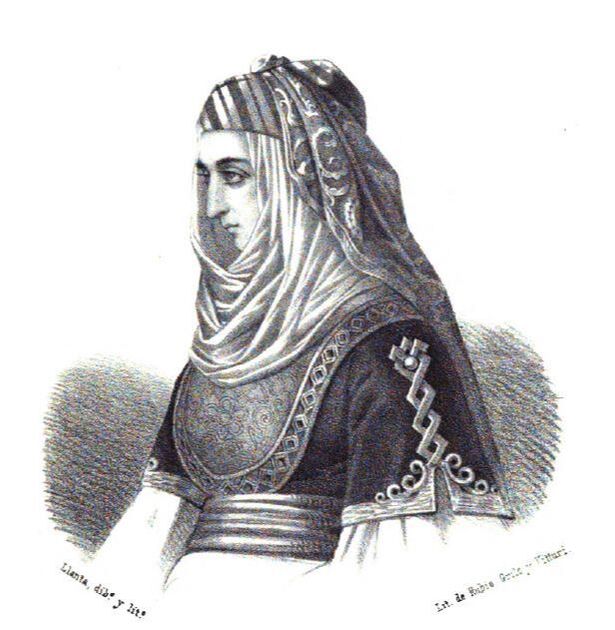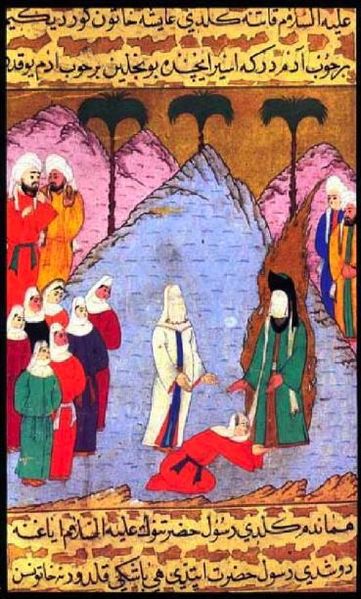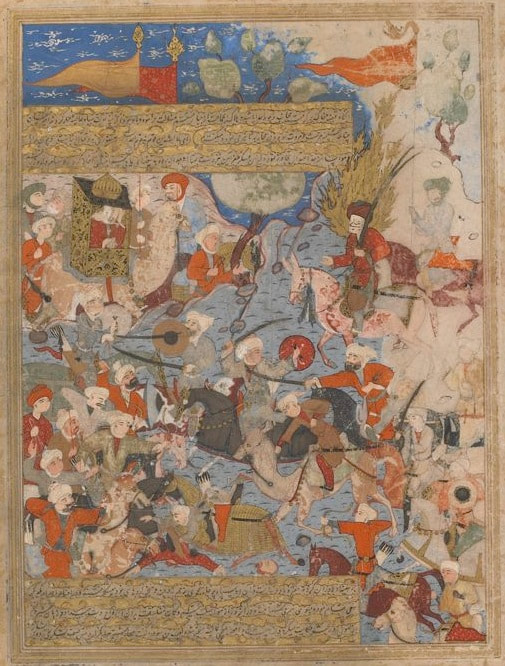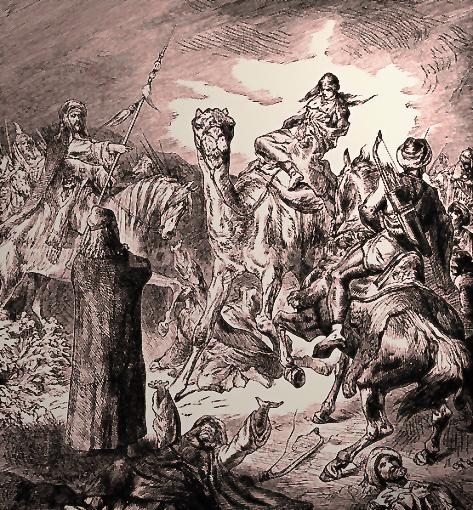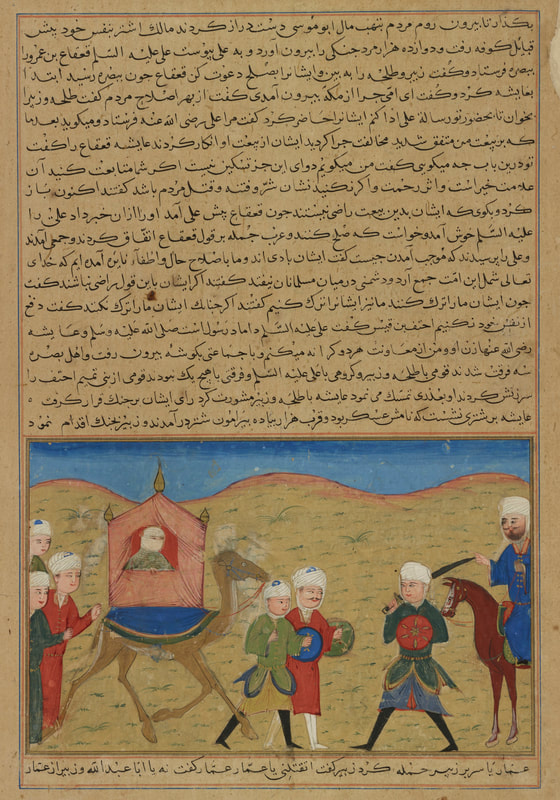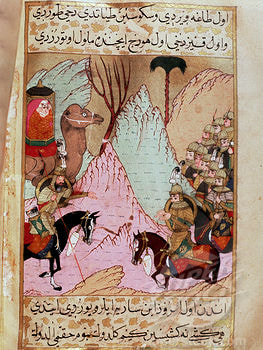If the knowledge of 'Aishah were to be gathered up and compared to the knowledge of all the other wives of the Prophet and all other women, 'Aishah's knowledge would be greater.
-Ibn Shihab al-Zuhri
syllabus
Explain the contribution to the development and expression of Islam of ONE significant person OR school of thought, other than Muhammad and the Four Rightly Guided Caliphs, drawn from:
- A’isha Bint AbuBakar
why A'isha?
‘A’isha bint Abi Bakr (d. 678 CE) is probably best known today as a wife of the Prophet Muhammad. Also transcribed as Aisha, she was Muhammad's third and youngest wife. In Islamic writings, her name is thus often prefixed by the title "Mother of the Believers" despite her never having a child.Aisha had an important role in early Islamic history, both during Muhammad's life and after his death. In Sunni tradition, Aisha is portrayed as scholarly and inquisitive. She contributed to the spread of Muhammad's message and served the Muslim community for 44 years after his death. She is also known for narrating 2210 hadiths, not just on matters related to Muhammad's private life, but also on topics such as inheritance, pilgrimage, and eschatology. Her intellect and knowledge in various subjects, including poetry and medicine, were highly praised by early Muslim scholars.
Her father, Abu Bakr, became the first caliph to succeed Muhammad, and after two years was succeeded by Umar. During the time of the third caliph Uthman, Aisha had a leading part in the opposition that grew against him, though she did not agree either with those responsible for his assassination nor with the party of Ali. During the reign of Ali, she wanted to avenge Uthman's death, which she attempted to do in the Battle of the Camel. She participated in the battle by giving speeches and leading troops on the back of her camel. She ended up losing the battle, but her involvement and determination left a lasting impression. Because of her involvement in this battle, Shia Muslims have a generally negative view of Aisha.
Her father, Abu Bakr, became the first caliph to succeed Muhammad, and after two years was succeeded by Umar. During the time of the third caliph Uthman, Aisha had a leading part in the opposition that grew against him, though she did not agree either with those responsible for his assassination nor with the party of Ali. During the reign of Ali, she wanted to avenge Uthman's death, which she attempted to do in the Battle of the Camel. She participated in the battle by giving speeches and leading troops on the back of her camel. She ended up losing the battle, but her involvement and determination left a lasting impression. Because of her involvement in this battle, Shia Muslims have a generally negative view of Aisha.
what we need to know
CONTEXT
The times in which she lived:
The times in which she lived:
- 7th century Saudi Arabia
- Early Islam
- Most beloved/ youngest wife of Mohammad
- Lived during the age of Jahiliyya (ignorance) where women were seen as second class
|
CONTRIBUTION
Her contribution to Islam (effect on the religion):
|
IMPACT
Her impact on Islam (how her contribution spreads out to influence the lives of adherents of Islam):
|
'Aisha was like a bridge between the time of the prophet and the future of Islam' -Resit Haylamaz

16th-century version of a 14th-century original painting showing Fatima (foreground), on her way to a Jewish wedding party, receiving a parcel of the green cloak brought by the Angel Gabriel from Paradise, in the presence of Mohammed (on the right), his young wife Aisha (next to him), and family members. Ottoman miniature from Siyer-i Nebi (Life of the Prophet)
As you read through this unit, keep an ongoing timeline of the major events in Aisha's life.
context
Aisha was born 613 or early 614. She was the daughter of Umm Ruman and Abu Bakr of Mecca, two of Muhammad's most trusted companions. The idea to match Aisha with Muhammad was suggested after the death of Muhammad's first wife, Khadija. After this, the previous agreement regarding the marriage of Aisha with Jubayr ibn Mut'im was put aside by common consent.. British historian William Montgomery Watt suggests that Muhammad hoped to strengthen his ties with Abu Bakr.
Aisha's age at marriage has been a source of controversy and debate, and some historians, scholars and writers have revisited the previously-accepted timeline of her life. American historian Denise Spellberg states that "these specific references to the bride's age reinforce Aisha's pre-menarcheal status and, implicitly, her virginity". She notes that Aisha herself seemed to promote the fact that she was a virgin prior to her marriage to Muhammad, as a way to distinguish herself from his other, non-virginal wives. This was of great importance to those who supported Aisha's position in the debate of the succession to Muhammad.
In many Muslim traditions, Aisha is described as Muhammad's most beloved or favoured wife after his first wife, Khadija, who died before the migration to Medina took place. There are several hadiths, or stories or sayings of Muhammad, that support this belief. One relates that when a companion asked Muhammad, "who is the person you love most in the world?" he responded, "Aisha." Others relate that Muhammad built Aisha's apartment so that her door opened directly into the mosque, and that she was the only woman with whom Muhammad received revelations. They bathed in the same water and he prayed while she lay stretched out in front of him.
It is also important to note that there exists evidence that Muhammad did not view himself as entirely superior to Aisha, at least not enough to prevent Aisha from speaking her mind, even at the risk of angering Muhammad. On one such instance, Muhammad's "announcement of a revelation permitting him to enter into marriages disallowed to other men drew from her [Aisha] the retort, 'It seems to me your Lord hastens to satisfy your desire!'"
Furthermore, Muhammad and Aisha had a strong intellectual relationship. Muhammad valued her keen memory and intelligence and so instructed his companions to draw some of their religious practices from her.
When the son of a prominent companion of the Prophet asked his wife Aisha to veil her face, she answered, "Since the Almighty hath put on me the stamp of beauty, it is my wish that the public should view the beauty and thereby recognised His grace unto them. On no account, therefore, will I veil myself."
Aisha was jealous of Khadija who was the first wife of the Prophet Muhammad, saying, "I did not feel jealous of any of the wives of the Prophet as much as I did of Khadija though I did not see her, but the Prophet used to mention her very often, and when ever he slaughtered a sheep, he would cut its parts and send them to the women friends of Khadija. When I sometimes said to him, "(You treat Khadija in such a way) as if there is no woman on earth except Khadija," he would say, "Khadija was such-and-such, and from her I had children."
In Hadith Sahih Muslim 4:2127 Aisha has an altercation with Muhammad saying, "He struck me on the chest which caused me pain and [he] then said: Did you think that Allah and His Apostle would deal unjustly with you?".
When Mohammad became became ill and suspected that he was probably going to die, he remained in Aisha's apartment until his death, and his last breath was taken as he lay in the arms of Aisha, his most beloved wife.
Aisha's age at marriage has been a source of controversy and debate, and some historians, scholars and writers have revisited the previously-accepted timeline of her life. American historian Denise Spellberg states that "these specific references to the bride's age reinforce Aisha's pre-menarcheal status and, implicitly, her virginity". She notes that Aisha herself seemed to promote the fact that she was a virgin prior to her marriage to Muhammad, as a way to distinguish herself from his other, non-virginal wives. This was of great importance to those who supported Aisha's position in the debate of the succession to Muhammad.
In many Muslim traditions, Aisha is described as Muhammad's most beloved or favoured wife after his first wife, Khadija, who died before the migration to Medina took place. There are several hadiths, or stories or sayings of Muhammad, that support this belief. One relates that when a companion asked Muhammad, "who is the person you love most in the world?" he responded, "Aisha." Others relate that Muhammad built Aisha's apartment so that her door opened directly into the mosque, and that she was the only woman with whom Muhammad received revelations. They bathed in the same water and he prayed while she lay stretched out in front of him.
It is also important to note that there exists evidence that Muhammad did not view himself as entirely superior to Aisha, at least not enough to prevent Aisha from speaking her mind, even at the risk of angering Muhammad. On one such instance, Muhammad's "announcement of a revelation permitting him to enter into marriages disallowed to other men drew from her [Aisha] the retort, 'It seems to me your Lord hastens to satisfy your desire!'"
Furthermore, Muhammad and Aisha had a strong intellectual relationship. Muhammad valued her keen memory and intelligence and so instructed his companions to draw some of their religious practices from her.
When the son of a prominent companion of the Prophet asked his wife Aisha to veil her face, she answered, "Since the Almighty hath put on me the stamp of beauty, it is my wish that the public should view the beauty and thereby recognised His grace unto them. On no account, therefore, will I veil myself."
Aisha was jealous of Khadija who was the first wife of the Prophet Muhammad, saying, "I did not feel jealous of any of the wives of the Prophet as much as I did of Khadija though I did not see her, but the Prophet used to mention her very often, and when ever he slaughtered a sheep, he would cut its parts and send them to the women friends of Khadija. When I sometimes said to him, "(You treat Khadija in such a way) as if there is no woman on earth except Khadija," he would say, "Khadija was such-and-such, and from her I had children."
In Hadith Sahih Muslim 4:2127 Aisha has an altercation with Muhammad saying, "He struck me on the chest which caused me pain and [he] then said: Did you think that Allah and His Apostle would deal unjustly with you?".
When Mohammad became became ill and suspected that he was probably going to die, he remained in Aisha's apartment until his death, and his last breath was taken as he lay in the arms of Aisha, his most beloved wife.
AFTER MUHAMMAD'S DEATH
After Muhammad's death, which ended Aisha and Muhammad's 14-year-long marriage, Aisha lived fifty more years in and around Medina. Much of her time was spent learning and acquiring knowledge of the Quran and the sunnah of Muhammad. Aisha was one of three wives who memorised the Qur'an. Like Hafsa, Aisha had her own script of the Quran written after Muhammad's death. During Aisha's life many prominent customs of Islam, such as veiling of women, began.
Aisha's importance to revitalising the Arab tradition and leadership among the Arab women highlights her magnitude within Islam. Aisha became involved in the politics of early Islam and the first three caliphate reigns: Abu Bakr, ‘Umar, and ‘Uthman. During a time in Islam when women were not expected, or wanted, to contribute outside the household, Aisha delivered public speeches, became directly involved in war and even battles, and helped both men and women to understand the practices of Muhammad.
Aisha garnered more special privilege in the Islamic community for being known as both a wife of Muhammad and the daughter of the first caliph.
After Muhammad's death, which ended Aisha and Muhammad's 14-year-long marriage, Aisha lived fifty more years in and around Medina. Much of her time was spent learning and acquiring knowledge of the Quran and the sunnah of Muhammad. Aisha was one of three wives who memorised the Qur'an. Like Hafsa, Aisha had her own script of the Quran written after Muhammad's death. During Aisha's life many prominent customs of Islam, such as veiling of women, began.
Aisha's importance to revitalising the Arab tradition and leadership among the Arab women highlights her magnitude within Islam. Aisha became involved in the politics of early Islam and the first three caliphate reigns: Abu Bakr, ‘Umar, and ‘Uthman. During a time in Islam when women were not expected, or wanted, to contribute outside the household, Aisha delivered public speeches, became directly involved in war and even battles, and helped both men and women to understand the practices of Muhammad.
Aisha garnered more special privilege in the Islamic community for being known as both a wife of Muhammad and the daughter of the first caliph.
AISHA DURING THE TIME OF THE FOUR RIGHTLY GUIDED CALIPHS
Read the Wikipedia link below on Aisha's role during the 2nd, 3rd and 4th Caliphates.
In your books, summarise her role during each in three dot points.
Read the Wikipedia link below on Aisha's role during the 2nd, 3rd and 4th Caliphates.
In your books, summarise her role during each in three dot points.
Contributions
- Education and interpretation of Sacred texts
- Tradition and Law
- Spreading the word of the Prophet
Aisha was blessed with an astounding memory and never forgot something once she heard it. She is said to have narrated 2210 ahadith (plural for hadith- narrations of the Prophet’s life and sayings) in her lifetime. As such she was one of the most prolific muhadditha (hadith narrator).
All who knew her respected her great intellect. Abu Musa al-Ashari (may Allah be pleased with him), a companion of the Prophet (PBUH) once said: “If we companions of the Messenger of God had any difficulty on a matter, we asked Aisha about it.”
impact
- The role of women in Islam
- The direction of Islam after Mohammad's death
- Connecting the Umma with Mohammad
Aisha's marriage has given her significance among many within Islamic culture, becoming known as the most learned woman of her time. Being Muhammad's favourite wife, Aisha occupied an important position in his life. When Muhammad married Aisha in her youth, she was accessible "...to the values needed to lead and influence the sisterhood of Muslim women." After the death of Muhammad, Aisha was discovered to be a renowned source of hadiths, due to her qualities of intelligence and memory. Aisha conveyed ideas expressing Muhammad's practice (sunnah). She expressed herself as a role model to women, which can also be seen within some traditions attributed to her. The traditions regarding Aisha tell us that she habitually opposed ideas unfavourable to women in efforts to elicit social change.
The so-called Muslim women’s movement is predicated on the idea that Muslim men, not Islam, have been responsible for the suppression of women’s rights. For this reason, Muslim feminists throughout the world are advocating a return to the society Muhammad originally envisioned for his followers. Despite differences in culture, nationalities, and beliefs, these women believe that the lesson to be learned from Muhammad in Medina is that Islam is above all an egalitarian religion. Their Medina is a society in which Muhammad designated women like Umm Waraqa as spiritual guides for the Ummah; in which the Prophet himself was sometimes publicly rebuked by his wives; in which women prayed and fought alongside the men; in which women like Aisha and Umm Salamah acted not only as religious but also as political—and on at least one occasion military—leaders; and in which the call to gather for prayer, bellowed from the rooftop of Muhammad’s house, brought men and women together to kneel side by side and be blessed as a single undivided community.- Reza Aslan
Aisha contributed her scholarly intellect to the development of Islam. She was given the title al-Siddiqah, meaning 'the one who affirms the truth'. Aisha was known for her "...expertise in the Quran, shares of inheritance, lawful and unlawful matters, poetry, Arabic literature, Arab history, genealogy, and general medicine." Her intellectual contributions regarding the verbal texts of Islam were in time transcribed into written form, becoming the official history of Islam.
During Aisha's entire life she was a strong advocate for the education of Islamic women, especially in law and the teachings of Islam. She was known for establishing the first madrasa (Muslim school) for women in her home. Attending Aisha's classes were various family relatives and orphaned children. Men also attended Aisha's classes, with a simple curtain separating the male and female students.
Aisha was also considered to be the embodiment of proper rituals while partaking in the pilgrimage to Mecca, a journey she made with several groups of women. For the last two years of her life, Aisha spent much of her time telling the stories of Muhammad, hoping to correct false passages that had become influential in formulating Islamic law.
Aisha died at her home in Medina on 17 Ramadan 58 AH (16 July 678). She was 67 years old.
During Aisha's entire life she was a strong advocate for the education of Islamic women, especially in law and the teachings of Islam. She was known for establishing the first madrasa (Muslim school) for women in her home. Attending Aisha's classes were various family relatives and orphaned children. Men also attended Aisha's classes, with a simple curtain separating the male and female students.
Aisha was also considered to be the embodiment of proper rituals while partaking in the pilgrimage to Mecca, a journey she made with several groups of women. For the last two years of her life, Aisha spent much of her time telling the stories of Muhammad, hoping to correct false passages that had become influential in formulating Islamic law.
Aisha died at her home in Medina on 17 Ramadan 58 AH (16 July 678). She was 67 years old.
"Aisha contributed to the growth, development, and understanding of Islam. Being a role model to a significant amount of others added to her attributions as a consultant regarding Muhammad's prayer and practices, soon introducing herself into a world of politics" -Muslim Names, Adam Marlow.
CC: And that – when you mentioned the Prophet Muhammed – is perhaps an excellent way for us to leap right into some of that analysis. I know that the undergrads at New College, in Edinburgh, will be quite familiar with the chapter of the book that focuses on the Prophet’s relationship with his wife Aisha, so maybe we could use that as an example of these various competing discourses and how people use claims to authority to negotiate sexual ethics?
KA: Sure, so of course, for the pre-modern Muslim tradition, Aisha is an absolutely vital figure. She is the youngest of the Prophet’s wives, many say his favourite wife – certainly after Khadijah died, who was the wife of his younger years – and she’s a scholar,and she’s a contentious political figure and certainly, for the construction of Sunni identity, she becomes a flash point in those debates over loyalty, over succession, over precedence. And Chase Robinson – I’m going to paraphrase him now – says that Early Christians argued about Christology and early Muslims argued over how 7th-century Muslims’ behaviour should be remembered, right? So, later Muslims are trying to construct their own authentic narratives, their own strategies of power, by reference to these early Muslims. And so Aisha was absolutely central there. Which means that the ways in which she’s remembered ends up being very central. The texts that are giving people fits today really are texts about her marriage, in which she reports in the first person, in Hadith narratives – narratives of Prophetic tradition – that she was six or, in another version, seven when the prophet married her, and nine when the marriage was consummated. And there are other details sometimes given in these accounts. Now it’s useful to point out that this isn’t something that people were particularly worried about for a very long time. And its actually really unusual that any of his wives ages would be so important in texts about the marriage. But this is there in the Hadith compilations that we have from the 9th-century. And this is similar to the ages that are reported by early biographers, who maybe sometimes go as high as 10. But really, its quite a young age that’s reported in these texts. And generally, over the centuries, Muslim biographers didn’t particularly have any issue with this. Western biographers didn’t particularly have any issue with this. None of them took much notice, until we get to just about 1700, when Humphrey Prideaux, who was an Anglican clergyman, writes a very nasty biography of Muhammed as, actually, part of his ongoing debate with Unitarian Christians. And he says, “Oh isn’t this sort-of amazing there in Arabia, which is the same clime as India,” just like in all these other hot countries, the torrid zone, “how women mature so quickly”. And, for him, Aisha’s age of 6 and 8 is an indication of something that is sort-of exotic and erotic. What he’s worrying about, though, is that Muhammed is marrying her to make an allegiance with her father, which shows that he is making a power grab, in service of his fraudulent imposture. And basically, it only is really in the late 19th/early 20th-century that people start to, maybe, wonder about this a little bit . . . Western biographers. And by the late 20th-century it’s making lots of people uncomfortable, including some Muslims. So the Arabic translation of Washington Irving, for instance – who though this was all very romantic in the middle of the 19th-century – in the 1960s, when its being translated in Egypt, the translator adds a real note, right? And the original marriage has been demoted to a betrothal, and then the translator feels the need to sort-of explain this. But, by the time I’m writing Sexual Ethics and Islam, the context is different and there are two very serious competing strains. There’s a set of polemical accusations that Muhammed is a paedophile, which the Rev Jerry Vines has linked in an epithet as “Demon-possessed paedophile“. So he’s linking a very old accusation against Muhammed with a very new one: a sort of medicalised rhetoric of evil. And then you start to have Muslim apologetics around this question, which say several things. One is that, “Well, things were different back then”. And a version of that is what a number of secular, sympathetic Western academics have also said. And then, the other thing that you get is, “Well, these texts really aren’t reliable on this point.” And the thing that I point out in Sexual Ethics and Islam is: it’s completely fine if you want to make that argument, but then it’s a problem if you turn to those texts as absolutely true on everything else. The thing that was really striking for me, after writing Sexual Ethics and Islam and moving onto the project that became the Lives of Muhammed – which is an investigation of Biographical texts, specifically – is the ways in which, so often in early texts, numbers have a particular kind of symbolic function and resonance. And while I don’t know that six and seven, or nine and ten have the symbolic resonance that say forty does in the accounts of Khadijah’s age, it seems to me that there is plausibly . . . I don’t want to say probably, and I don’t think we can ever know with any kind of certainty these are factually accurate unless we’re simply willing to say, “These texts are all factually accurate and we accept that.” It seems to me, plausibly, there’s an argument to be made that the very low numbers given for her age are in service of praising her, actually; of presenting her as a particularly pure figure, which is very important given that her chastity was impugned during her lifetime, or at least according to texts.They represent this as something that was challenged. And so making her so young at marriage, emphasising her virginity, becomes a way of emphasising her sexual purity. The other thing, it seems to me, is that it’s possible that making her, say nine, when the marriage is consummated, after the Hijrah to Medina, is also a way of making her age low enough that she’s indisputably born to Muslim parents. So although virtually everybody in that first Muslim community would be a convert – according to pious narratives – by the time these Hadith texts are being compiled, having your parents already be Muslim, being born to Muslim parents is quite a status marker. It becomes important to have a genealogy of Muslim parents going further back.
